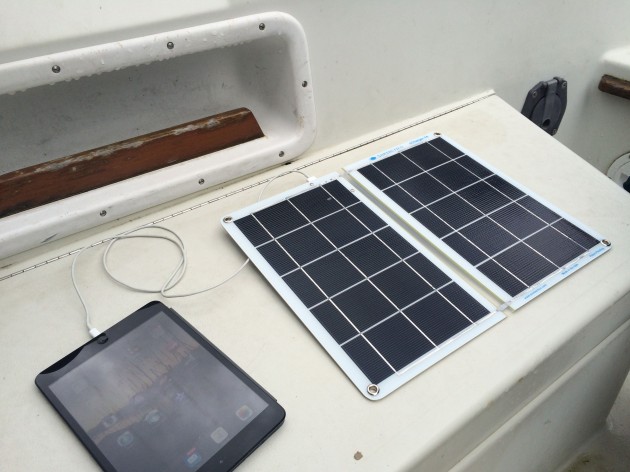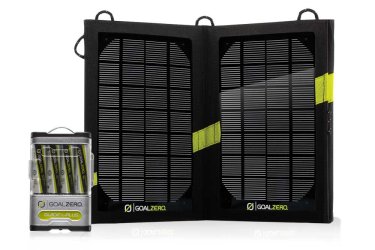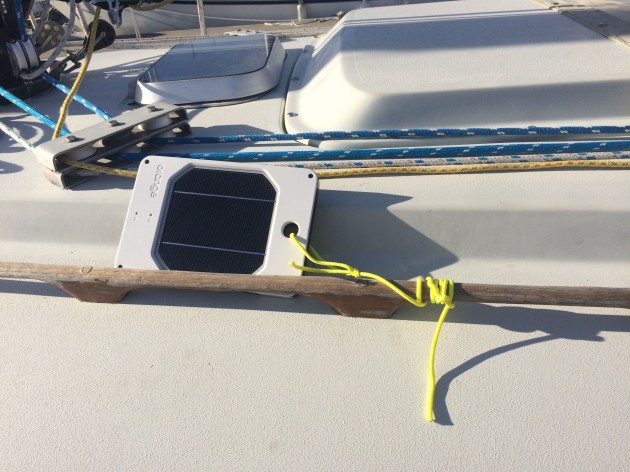Portable Solar Panels: Mobile Juice for Your Mobile Devices
Keeping your devices charged while afloat has never been easier, but there are a few catches.
So what do you do when you’re out on the water and your smartphone or tablet battery dies? Charge it up via the sun, that’s what you do.
Portable solar panels can be a great solution for keeping your mobile devices charged afloat, and there are several products available. To help you choose, I tested three products with high consumer ratings that looked robust enough for marine use.
Portable solar charging solutions typically consist of a solar panel, a charging unit, and an optional battery pack. They are different from typical 12-volt battery trickle chargers in that these portable panels have places to plug in your devices via USB or Mini USB.

The Suntactics sCharger-14 provides a lot of juice, but devices have to be plugged directly into it, which can leave them in danger of being stepped on or falling overboard.
Suntactics sCharger-14
The Suntactics sCharger-14 is the largest model we tested, equipped with two large panels and two USB charging ports. With 2.8 amps of power, it also provided the fastest charge time (around two hours for my smartphone) while still performing reasonably well in overcast/hazy conditions. The solid design makes it very robust, and it has useful grommets for securing it to the deck, fixed rigging, lifelines, or other locations.
It also has a handy auto-retry feature, which is very useful for mobile devices that require a consistent charge rate. This works by restarting the charging cycle every five minutes in case the amps drop because of cloud cover or shade. The only downside to this feature is that the device you have attached will keep waking up/going to sleep, and this can actually further deplete your battery.
At $249.99 the the Suntactics sCharger-14 is the most expensive of the three we tested.
For more information, visit Sunactics.

The Guide 10 Kit has a handy rechargeable battery pack with removable AA batteries than can be used for other devices, such as flashlights or cameras.
Goal Zero Guide 10 Plus Kit
Like the Suntactics unit, the Goal Zero Guide 10 Plus is a multi-panel charger. The two main differences between it and the Suntactics kit are that it comes with a folding fabric sleeve and a battery pack with four rechargeable AA batteries that can be charged from the panels. The handy thing about this battery pack is that in addition to plugging your smartphone or tablet into it, you can also remove those AA batteries for use in other devices, such as a flashlight or camera.
I liked that the Guide 10 Plus Kit is very flexible and comes with multiple attachment points that allow you to clip it just about anywhere. But I did have concerns about the cloth protective sleeve getting wet and damaging the panels over time, especially when boating in saltwater locales.
But the main drawback of the Guide 10 Plus Kit was its output. It just could not consistently charge an iPhone 5, even in sunlight, so I would only go with this option if you expect very bright conditions. (The specs say is has an output of 1 amp, which should be sufficient for a iPhone that needs at least 800 milliamps to charge).
The Guide 10 Plus Kit retails for $119.95.
For more information, visit Goal Zero.

The Solar JOOS Orange had a nifty attachment point that I liked, but I also found myself wishing it had another, given the way this panel's slippery case allowed it to move around on deck so much.
Solar JOOS Orange
This product is a different animal. It comes with its own internal battery, internal legs to prop it up, and also has a waterproof exterior with a rubber cover for the charging port. This makes it far more versatile for boat use.
But what makes this product really stand out is that it works in real-world light conditions including low light and partial shade. You’ll want to plan for a longer charge time with this panel (3.5 to 4 hours), but to help with this, you can get the optional boost reflectors. Imagine those suntan reflectors from the ’80s and you’ll get the idea.
On the downside, it only has a Mini-USB port. This means you’ll need various easy-to-lose adaptors for devices like the iPhone that don’t use Mini-USB.
The single attachment point was large enough to secure it to the boat with a shackle or a line, but we found ourselves wanting a second attachment point to keep its slippery plastic case from slipping all over the place.
The Solar JOOS Orange kit and reflector panels retail for around $170.00.
For more information, visit Solar JOOS.
While I'm still waiting for the perfect mobile device solar panel charger for use while boating, I would go with the SolarJoos. Its size, cost, and internal battery put it a step above the others for the cost.











